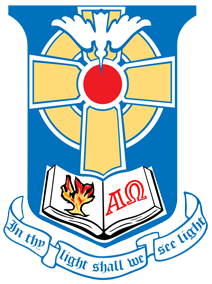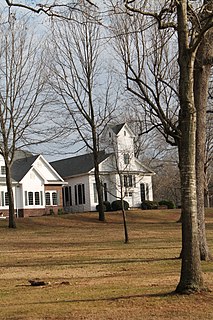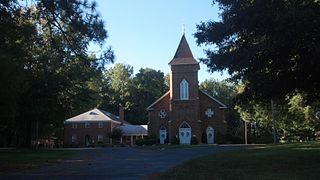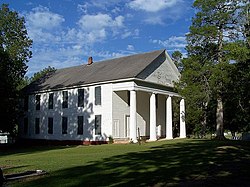
The Associate Reformed Presbyterian Church (ARPC), as it exists today, is the historical descendant of the Synod of the South, a Synod of the Associate Reformed Church. The original Associate Reformed Church resulted from a merger of the Associate Presbytery and most of the Reformed Presbytery in Philadelphia in 1782. The northern Synods eventually merged with the forebearers of the Presbyterian Church (USA).

St Andrew's Presbyterian Church is a Presbyterian church at 32 Moon Street, Wingham, New South Wales. The church is the main centre of the Wingham and Upper Manning Parish. The other centre is St Thomas' Presbyterian Church, Krambach.

Chapel of the Cross is a parish of the Episcopal Church of the United States in Chapel Hill in the Diocese of North Carolina. It is the spiritual home to more than 1,600 communicants, including numerous students studying at the University of North Carolina at Chapel Hill.

The Church of the Presidents is a former Episcopal chapel on the Jersey Shore where seven United States presidents worshipped. It was visited by presidents Ulysses S. Grant, Rutherford B. Hayes, James A. Garfield, Chester A. Arthur, Benjamin Harrison, William McKinley, and Woodrow Wilson. All except Grant were in office when they paid their visits to the church.

Fifth Avenue Presbyterian Church is a Presbyterian Church (U.S.A.) church in New York City. The church, on Fifth Avenue at 7 West 55th Street in Midtown Manhattan, has approximately 2,200 members and is one of the larger PCUSA congregations. The church, founded in 1808 as the Cedar Street Presbyterian Church, has been at this site since 1875.

Trinity Episcopal Church, now known as Trinity Episcopal Cathedral, is the first Episcopal and the oldest surviving sanctuary in Columbia, South Carolina. It is a Gothic Revival church that is modeled after York Minster in York, England. It was named to the National Register of Historic Places on February 24, 1971.

Old Brick Church, which is also known as Ebenezer Associate Reformed Presbyterian (ARP) Church or First Associate Reformed Presbyterian Church is a church built in 1788 about 4 mi (6 km) north of Jenkinsville on SC 213 in Fairfield County, South Carolina. It was named to the National Register of Historic Places on August 19, 1971. It is one of the few 18th-century churches surviving in the South Carolina midlands.

Springfield Baptist Church in Augusta, Georgia was founded in 1787 by Rev. Jesse Peters Saint John Methodist Church donated a wooden structure for them to worship in brought to its current location on logs. The present brick structure was built in 1812 by the churches congregation under the leadership of Rev. G.H. Dwellers. It is the oldest church building extant in Augusta and claimed to be the oldest congregation in the state of Georgia. It was built in the style of a New England meetinghouse, rare in Georgia.

Stoney Creek Independent Presbyterian Chapel of Prince William Parish or Stoney Creek Presbyterian Chapel is a chapel in southeastern Hampton County, South Carolina, United States in the unincorporated community of McPhersonville, South Carolina about 4 mi (6 km) west of Yemassee. In the USGS Geographic Names Information System, it is called McPhersonville Church. It was built about 1833. It is one block north of Pocotaglio Road on State Highway 25-286. The chapel is only antebellum structure in McPhersonville. It was named to the National Register of Historic Places on May 22, 2002.

Rocky Spring Presbyterian Church is a historic Presbyterian church in Letterkenny Township, Franklin County, Pennsylvania. It was built in 1794, and is a 1 1/2-story, four by six bay, brick Georgian style building. It measures 48 feet by 60 feet, and has a gable roof. The interior of the church includes two ten-plate stoves; brick aisle ways; a crude ladder leading to a loft; and wooden pews that are long and narrow with high straight-backed seating. The ends of the pews are carved with the names of the previous occupants identifying the military ranks they held during the Revolutionary War. Rocky Springs Church was a pay for pew church that required members to sign a financial agreement between the trustees of the church and the pew holders requiring an annual fee for occupancy of the pew. The Church's pulpit is circular in form and positioned above the pews giving the speaker full view of the congregation. Access is gained by a staircase. Above the pulpit is an oval-shaped canopy or sounding board.

Ebenezer Academy, Bethany Presbyterian Church and Cemetery is a historic school building, Presbyterian church, and cemetery located six miles north of Statesville, Iredell County, North Carolina. The log building was constructed in 1823 and housed Ebenezer Academy. The church building was built about 1855, and is a one-story, three bay by five bay, vernacular Greek Revival style frame building with a low gable roof. Also on the property is the contributing church cemetery with burials dating to about 1785.

Coddle Creek Associate Reformed Presbyterian Church, Session House and Cemetery is a historic Associate Reformed Presbyterian church located near Mooresville in Iredell County, North Carolina, United States.

Grace Church is one of the oldest churches in North Carolina, having been organized about 1745 as a Reformed congregation. The current church building dates from 1795.

Thyatira Presbyterian Church, Cemetery, and Manse is a historic church at 220 White Road off NC 150 in Mill Bridge in Rowan County, North Carolina, ten miles west of the town of Salisbury. Presbyterians have been worshiping at this site since at least 1753.

Bethel Presbyterian Church is a historic Presbyterian church near Clover, South Carolina.

Valley Creek Presbyterian Church is a historic Presbyterian church in Valley Grande, Alabama, United States. The two-story red brick church building was built in the Greek Revival-style from 1857–1859. The sanctuary and a mezzanine level, formerly a slave gallery, are located on the upper floor. It was added to the National Register of Historic Places on May 28, 1976, due to its architectural significance.

The Millen House is a historic residence on the campus of Indiana University in Bloomington, Indiana, United States. Built by an early farmer, it is one of Bloomington's oldest houses, and it has been named a historic landmark.

Hebron Church is a mid-19th-century Lutheran church in Intermont, Hampshire County, in the U.S. state of West Virginia. Hebron Church was founded in 1786 by German settlers in the Cacapon River Valley, making it the first Lutheran church west of the Shenandoah Valley. The congregation worshiped in a log church, which initially served both Lutheran and Reformed denominations. Its congregation was originally German-speaking; the church's documents and religious services were in German until 1821, when records and sermons transitioned to English.
Katherine Neel Dale was an American medical missionary of the Associate Reformed Presbyterian Church who served in Mexico; primarily in the states of San Luis Potosi and Tamaulipas, specifically Rio Verde and Tampico regions. Katherine and her husband, James G. Dale, served the Mexican people for over forty years, where she built up an extended practice, founded and built Dale Memorial Hospital, and founded the Mexican Indian Mission - which included schools for Indian girls and boys.























